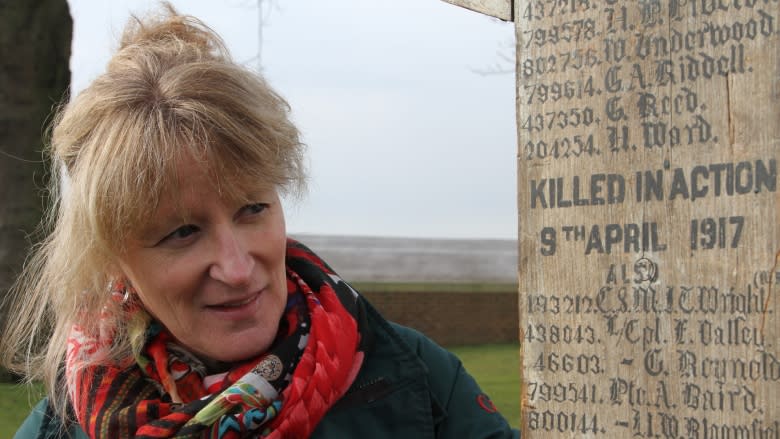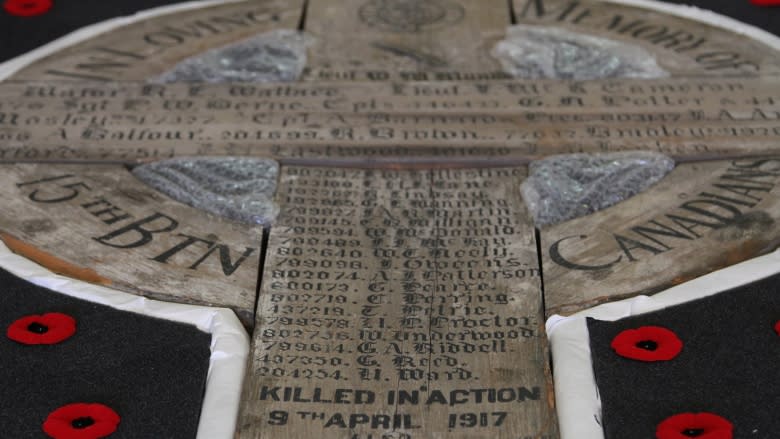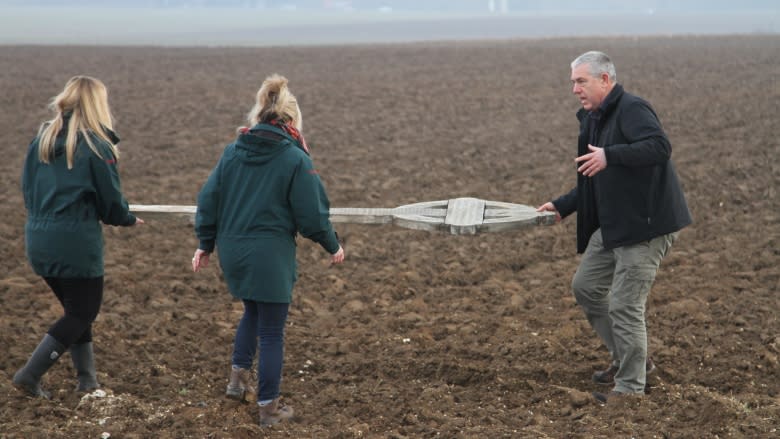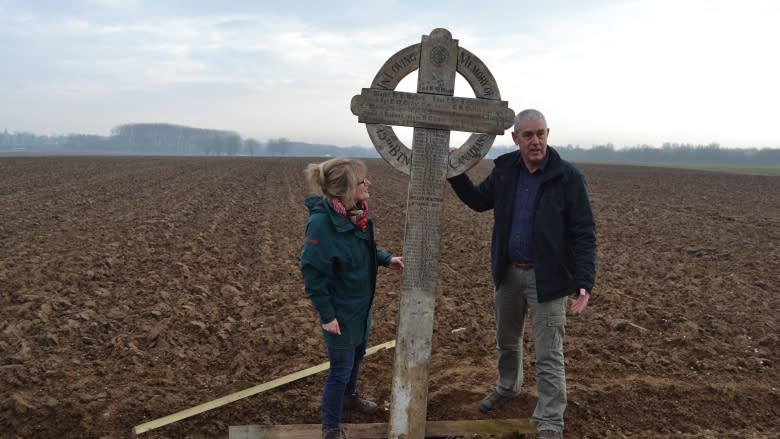Raised in early hours of Vimy battle, cross honouring Canadians returns to France
Few memorials speak of monumental loss as eloquently as the limestone twin pillars at Vimy Ridge.
But at the newly opened visitor centre a short walk away, there now stands one other tribute to Canada's war dead that speaks more intimately of the pain.
Until last month, the wooden, 100-year old battlefield cross was hanging in a museum housed in the basement of a Toronto church. But the rare relic that is going on display in Vimy this weekend once stood for years at the heart of one of the world's most hideous conflicts.
And that made it all the more fitting to have it in Vimy in time for the 100th anniversary commemoration.
Since the First World War, it has also crossed the ocean twice. Its return to France now is both a homecoming and a reunion.
The Celtic-style cross was made and raised in the battlefield, shortly after the assault on Vimy Ridge started on April 9, 1917.
Etched on its surface are the names of 57 Canadian soldiers, most from the 15th Battalion, and most of whom were killed in the first hours of that assault.
That makes it one of only a handful of surviving witnesses — and a real-time partial record — of the heavy Canadian losses in those pivotal opening moments of the battle.
"Although it's a cross that commemorates the men of one battalion, it's going back to tell the story of all the men who fought there," said Brig.-Gen (retired) Greg Young, of the 15th Battalion Memorial Project. It was his idea to offer Veterans' Affairs to send the cross over.
"It's special because it commemorates individuals who were maybe unknown but were themselves special for what they did."
The 15th Battalion was tasked with taking on the Eastern edge of the ridge, which meant advancing over a longer distance, and through more German lines than other Canadian units.
That meant heavy casualties despite their quick advance. Young says most of those killed were cut down by German machine gun and small arms fire.
The battalion had two makeshift graves prepared in advance for soldiers killed in action. The cross was made by the battalion's carpenter, and used to mark one of those two sites.
Young wanted to see the cross returned and, if only briefly, raised again at that very same spot.
At the other end in France, Johanne Gagne, a Veterans Affairs Canada project co-ordinator based in Vimy, had always dreamt of bringing over one of the few surviving battlefield crosses.
With the help of an avid, amateur historian, their dreams were realized when, after much preparation and legwork, the cross finally arrived in France in February.
Reaching across time
The exact circumstances aren't clear, but after the war, the cross was brought over to Canada, and had for years been on display in the museum dedicated to the 48th Highlanders regiment, in the basement of St. Andrew's Church.
It has helped countless Canadians reach across time and connect with the stories of relatives and memories buried by the passage of time.
So as a team of experts gingerly removed the cross from its display to pack it for the voyage back to Vimy, some of those relatives were invited to see it off.
Their stories bring the names alive.
O. (Orlando) Wilcox was a diamond setter in life, only 27 at his death. He left a daughter, and a twin who lived to be 96, according to his great nephew, Richard Merritt.
J. (John) Owens—whose name was misspelled on the cross with an extra e—was born in Ireland. He had worked as an electrician on the Titanic before immigrating to Canada.
Relatives of both of those men inherited photos and other relics, even a pistol, in Wilcox's case.
But not Scott Keen, who started researching his great grandfather five years ago.
"He's still a ghost," Keen said in a CBC News interview.
At an unusually old age of 43 — about the same age as Scott Keen now — Edwin Keen joined up, leaving behind his life as a bricklayer, his wife and four young children. The youngest was Scott Keen's grandfather.
That meant almost nothing of the elder Keen's memories was passed down through the family.
But through research, Keen learned his great grandfather was one of the first wave in the Vimy assault, and so killed immediately by a bullet sometime between 5:15 and 5:30 a.m. on April 9, 1917.
Seeing his name on the cross also helped bring him closer to the man for whom he named his own son.
"I want to be able to write something down, even if it's my own recollection of what I learned, so in generations from now somebody will have something to say that 'my great great great great great grandfather was at Vimy Ridge.'"
Flight back to France
On Feb. 13, on the red-eye Air Canada Flight 880, the cross was bound again for the old battlefield, like many a reluctant veteran.
It arrived the following morning, at Paris Charles de Gaulle airport in a specially constructed crate marked "fragile," then transported by truck all the way to the Vimy Ridge memorial park.
There to receive it were Gagne from Veterans Affairs, and Simon Godly, the amateur historian. It was an exhilarating moment.
Godly spent months painstakingly pinpointing the original location the cross was raised, using old maps and war diaries.
Today the spot is near the edge of a muddy farmer's field. You can barely make out Vimy Ridge in the distance.
"That's the difference between these kinds of crosses, and the [Vimy] Memorial," said Godly.
The memorial took years to conceive and build. But the cross was built by a fellow soldier as "a labour of love … in honour of the fallen. It's way more personal and immediate."
Together, Gagne and Godly raised it just long enough to take a photo.
As if it wanted to come back
For Gagne it was an emotional moment — the culmination of two years of work to bring the cross over.
"It's as if this cross wanted to come back home," said Gagne. "And now it's home."
When the war was over, the soldiers' bodies were exhumed and moved to the Nine Elms cemetery in Arras. The cross was moved there too and an image has survived of it standing guard near the entrance.
Owen, Wilcox and Keen were all given proper headstones, which remain standing.
Before it went on display, the cross was taken to the cemetery, to be reunited briefly with the men whose names it has carried for a hundred years.









